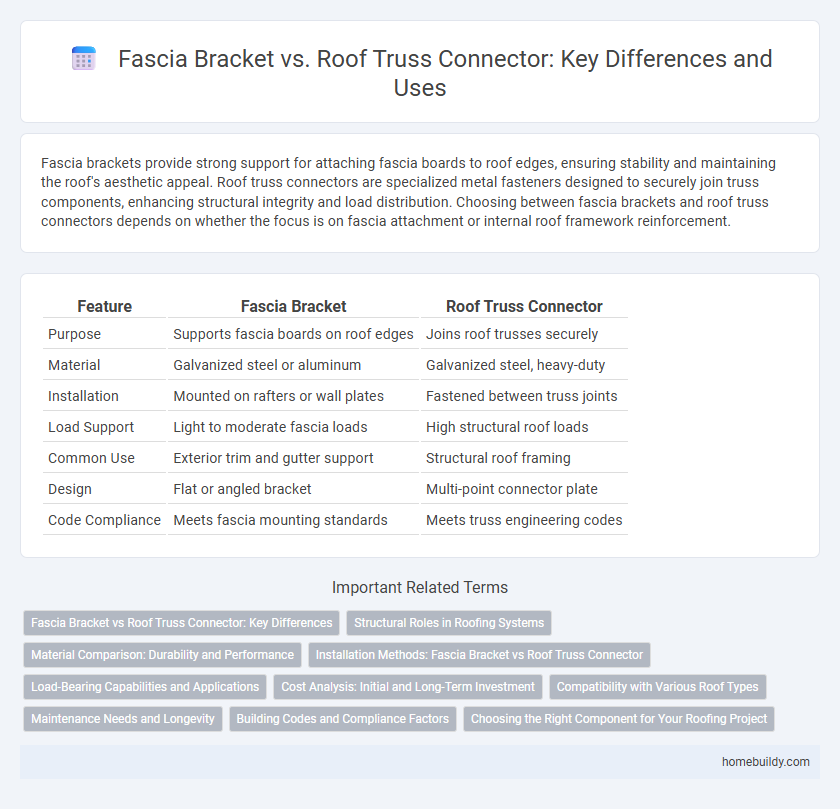Fascia brackets provide strong support for attaching fascia boards to roof edges, ensuring stability and maintaining the roof's aesthetic appeal. Roof truss connectors are specialized metal fasteners designed to securely join truss components, enhancing structural integrity and load distribution. Choosing between fascia brackets and roof truss connectors depends on whether the focus is on fascia attachment or internal roof framework reinforcement.
Table of Comparison
| Feature | Fascia Bracket | Roof Truss Connector |
|---|---|---|
| Purpose | Supports fascia boards on roof edges | Joins roof trusses securely |
| Material | Galvanized steel or aluminum | Galvanized steel, heavy-duty |
| Installation | Mounted on rafters or wall plates | Fastened between truss joints |
| Load Support | Light to moderate fascia loads | High structural roof loads |
| Common Use | Exterior trim and gutter support | Structural roof framing |
| Design | Flat or angled bracket | Multi-point connector plate |
| Code Compliance | Meets fascia mounting standards | Meets truss engineering codes |
Fascia Bracket vs Roof Truss Connector: Key Differences
Fascia brackets are specifically designed to attach fascia boards securely to the structure, providing strong support and alignment for roofing edges, while roof truss connectors primarily join truss components to ensure structural integrity of the roof framework. The key differences lie in their function and placement; fascia brackets focus on fascia reinforcement and aesthetic finish, whereas roof truss connectors focus on load distribution and stability within the roof's truss system. Materials used for fascia brackets often include galvanized steel for corrosion resistance, contrasting with heavy-duty steel plates common in roof truss connectors for maximum strength and durability.
Structural Roles in Roofing Systems
Fascia brackets primarily support and secure the fascia board, providing a mounting base that protects the roof edge and improves aesthetic appearance. Roof truss connectors serve as critical structural components that join trusses, ensuring stability and load distribution across the roofing framework. Their distinct roles contribute to overall roof integrity by combining edge protection with internal structural strength.
Material Comparison: Durability and Performance
Fascia brackets are typically made from galvanized steel or stainless steel, offering high resistance to corrosion and excellent durability in outdoor conditions. Roof truss connectors are often constructed from galvanized steel with additional coatings to enhance strength and prevent rusting under structural loads. The choice between fascia brackets and roof truss connectors depends on specific performance requirements, with fascia brackets optimized for aesthetic support and roof truss connectors designed for heavy-duty structural integrity.
Installation Methods: Fascia Bracket vs Roof Truss Connector
Fascia brackets are typically installed using screws or nails directly into the fascia board, providing a straightforward attachment point for gutters or cladding support, while roof truss connectors require precise alignment and fastening to the truss and framing members using metal plates or specialized hardware. The installation of fascia brackets demands less structural modification, making the process faster and more adaptable for exterior finishing. In contrast, roof truss connectors involve careful positioning to maintain structural integrity and often require professional expertise to ensure load-bearing safety.
Load-Bearing Capabilities and Applications
Fascia brackets provide essential support for fascia boards, primarily handling horizontal loads from gutters and cladding, while roof truss connectors are engineered to secure roof trusses with high load-bearing capacities for vertical and lateral forces. Roof truss connectors accommodate dynamic structural stresses, making them vital in roof framing systems, whereas fascia brackets are suited for stabilizing exterior finishes and protecting roof edges. Selection between fascia brackets and roof truss connectors depends on load requirements and structural functions in construction projects.
Cost Analysis: Initial and Long-Term Investment
Fascia brackets typically offer a lower initial cost compared to roof truss connectors due to simpler design and reduced material usage. Long-term investment for fascia brackets often results in reduced maintenance expenses, as they are easier to inspect and replace. Roof truss connectors, while more expensive initially, provide enhanced structural stability that can minimize costly repairs over the lifespan of the building.
Compatibility with Various Roof Types
Fascia brackets offer versatile compatibility with various roof types by securely attaching to roof edges without interfering with structural elements, making them ideal for both pitched and flat roofs. Roof truss connectors are specifically designed to join truss components, limiting their use to truss-based roof designs and reducing flexibility for alternative roof styles. Choosing fascia brackets enhances adaptability in roofing projects requiring attachment to fascia boards across diverse architectural configurations.
Maintenance Needs and Longevity
Fascia brackets generally require less maintenance due to their exposure to fewer structural stresses compared to roof truss connectors, which endure significant load and environmental factors. Roof truss connectors often demand regular inspections and occasional replacements to prevent corrosion and structural failure, impacting their overall longevity. Proper material selection and protective coatings enhance the lifespan of both components, with fascia brackets typically showing greater durability in low-stress applications.
Building Codes and Compliance Factors
Fascia brackets and roof truss connectors must comply with specific building codes such as the International Building Code (IBC) and local amendments dictating load requirements and material specifications. Fascia brackets primarily support aesthetic and protective elements on building exteriors, requiring compliance with wind load and corrosion resistance standards. Roof truss connectors address structural integrity, demanding higher compliance for shear strength and seismic performance to ensure safe load transfer within roof framing systems.
Choosing the Right Component for Your Roofing Project
Fascia brackets provide a robust solution for securing fascia boards to the roof edge, ensuring a clean finish and enhancing structural integrity. Roof truss connectors are engineered to join truss components, distributing loads and maintaining roof stability under various stresses. Selecting the right component depends on whether your project requires fascia board attachment or truss reinforcement, with fascia brackets optimizing edge aesthetics and roof truss connectors ensuring frame durability.
Fascia bracket vs Roof truss connector Infographic

 homebuildy.com
homebuildy.com